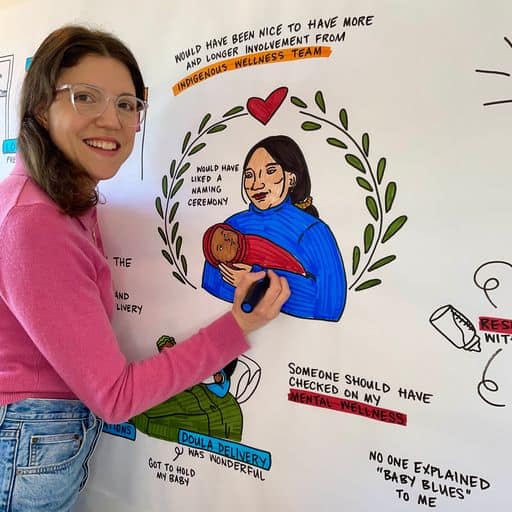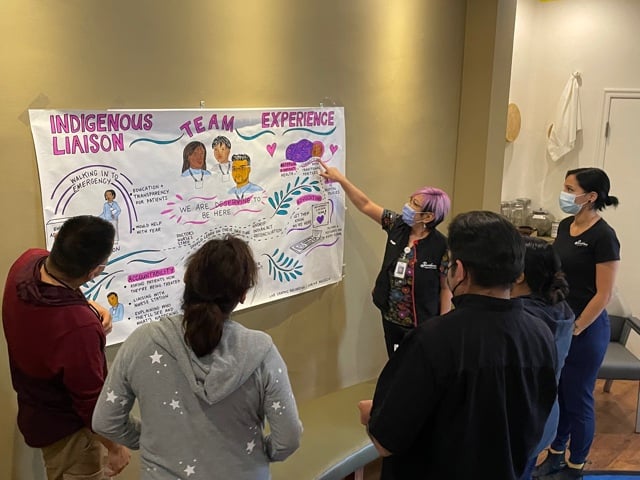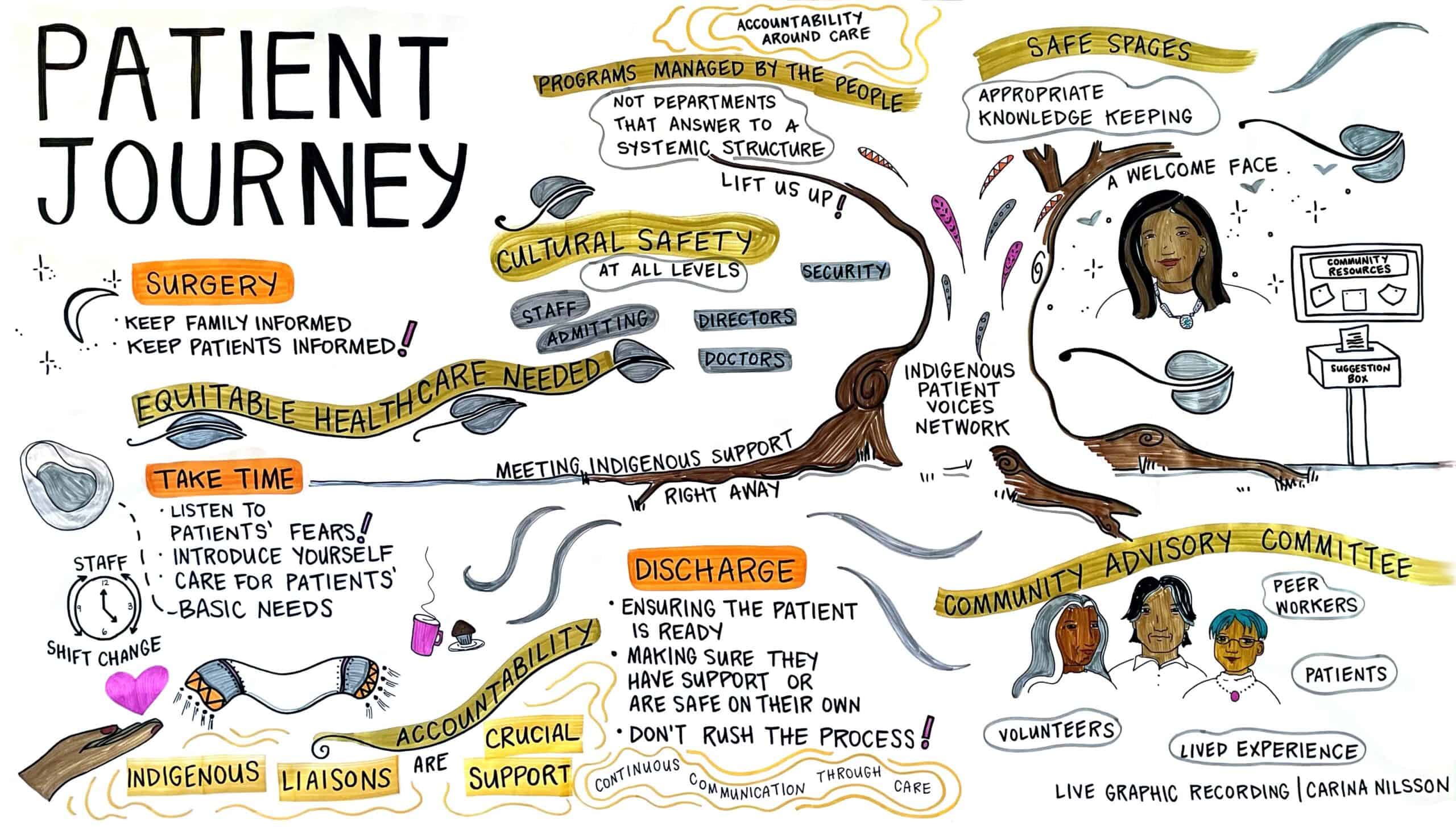“I received a blanket and sweetgrass from the Indigenous Liaison [Worker] and felt very cared for. It was good to see a welcoming face.”
“I felt racially profiled in the Emergency Department and was told numerous times that my symptoms were due to alcohol, or alcohol withdrawal.”
Two completely different experiences – recounted by two Indigenous patients who received care from St. Paul’s Hospital. Their accounts were captured by Providence Health Care’s first-ever patient journey mapping exercise with Indigenous patients.
Carried out by the Indigenous Wellness and Reconciliation Team at Providence Health Care (PHC), the patient journey mapping involved working with a graphic illustrator to produce a visual depiction of the steps and experiences of Indigenous (First Nation, Métis, and Inuit) patients as they moved through their care “journey”.

“The discussions were open-ended and exploratory,” said Sheri Hundseth, director of Indigenous Reconciliation and Community Engagement at PHC. “We started with the question ‘what was your experience at St. Paul’s Hospital?’ and let the patient lead the process. If needed, we had a set of questions to prompt further discussion.”
Between December 2021 and March 2022, Hundseth’s team interviewed 21 Indigenous patients who received care from various hospital departments.
Many patients reported experiences of culturally unsafe care or discriminatory behaviour. This wasn’t unexpected and it is one of the reasons the journey mapping process was carried out. As the 2020 In Plain Sight provincial report documented, discrimination against Indigenous people is still widespread in the health care system in BC.
As stated in its strategic plan Mission: Forward: Providence Health Care is committed to the process of Truth and Reconciliation with Indigenous Peoples and it is embedded in everything we do.
“Integrating that concept into such a large health care organization is a huge undertaking,” said Harmony Johnson, vice president of Indigenous Wellness and Reconciliation at PHC. “It starts with acknowledging and documenting our strengths and weaknesses in working with Indigenous people. You could say that patient journey mapping is one step on our organization’s overall journey to reconciliation, which we’ve set out for the first time in our Indigenous Wellness and Reconciliation Action Plan.”
In particular, journey mapping responds to the goal from the action plan to: “establish continuous, safe, and meaningful engagement processes with Indigenous organizations, patients and families so that we can continue to advance truth, justice, reconciliation, and cultural safety.”
“The journey mapping process itself supports the re-building of relationships, trust, and healing with Indigenous patients who do not trust health care providers – or the health system in general – due to negative past experiences”, said Johnson.

Indigenous journey mapping captures the experiences of individual patients – providing snapshots rather than comprehensive feedback or recommendations.
“This data provides a foundation for subsequent discussions within Providence Health Care,” said Hundseth. “We review it and use it to highlight systemic themes, recurring issues, and other opportunities to enhance cultural safety and trauma-informed care.”
One of the opportunities highlighted by the journey mapping stories is to expand the five-member Indigenous Wellness Liaison team. These Indigenous workers – who were also interviewed for the journey mapping project – provide a wide range of much-appreciated support to Indigenous patients.
“I was happy to see [the Indigenous liaison], I needed someone safe to talk to. The blanket [she gave me] was a good reminder that I was being cared for,” said one participant, a woman who received emergency cardiac care from four departments at St. Paul’s Hospital.
“The Indigenous Wellness Liaison Workers advocate for patients in the Providence system,” said Neil Fowler, manager of Indigenous Wellness at PHC. “Usually, they are focused on current patients. Participating in the journey mapping gave our team members a structured opportunity to advocate for change for future patients.”
Another opportunity indicated by the journey mapping accounts is to increase awareness among staff members of the All Nations Sacred Space at St. Paul’s Hospital – and to establish similar spaces and others – such as Indigenous medicinal gardens – at the new St. Paul’s Hospital and other PHC facilities.
“The Sacred Space felt like home. [It was a] nice feeling smelling the medicines – sage, sweetgrass – and seeing the colours. The room had a nice feeling,” said one of the patients.
A recurring topic raised by patients was the need for more traditional Indigenous food, underscoring the importance of an existing initiative at PHC to better understand and improve the food experience of Indigenous patients.
The individual stories of Indigenous patients as tracked in the journey mapping initiative bring a human face to large, systemic issues Providence Health Care is addressing as it works to become – as Neil Fowler describes it – “the organization that Indigenous patients want to go to for their wellness.”
Patient journey mapping is a simple, yet incredibly powerful exercise that brings together patients, facilitators, and a graphic illustrator to produce a visual “map” of the journey Indigenous patients experienced. Not only does this amplify Indigenous patients’ voices, it helps the IWR team and their PHC colleagues identify areas where we can improve care.
